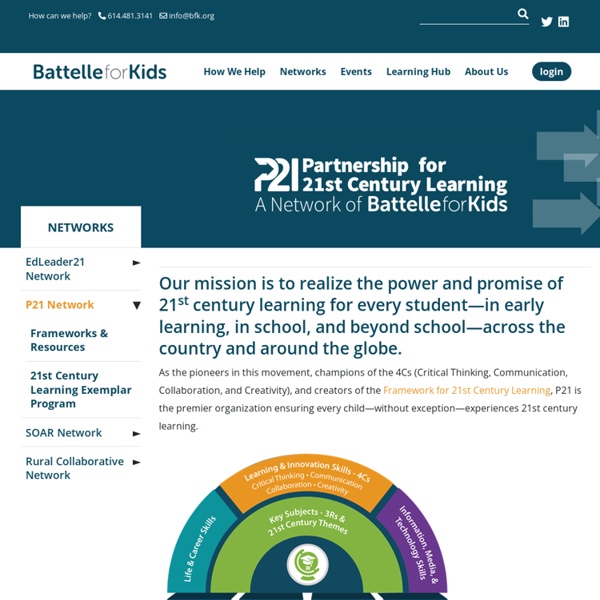Zoom
Trash



http://www.battelleforkids.org/networks/p21
Related: 21st Century Skills in Education • 21st Century Literacies • EDUC 548 • (Lern)Kultur15 Characteristics of a 21st-Century Teacher Recent technological advances have affected many areas of our lives, including the way we communicate, collaborate, learn, and, of course, teach. Those advances necessitate an expansion of our vocabulary, producing definitions such as digital natives, digital immigrants, and the topic of this post—21st-century teacher. As I write this, I’m trying to recall if I ever had heard phrases such as 20th-century teacher or 19th-century teacher. Quick Google searches reassure me that there are no such word combinations.
Developing students' digital literacy The issue Even today’s students need support with some areas of digital practice, particularly in an academic context, so it’s important to make sure that these needs are met. While employability is an obvious driver, developing learners who can learn and thrive in a digital society is a key role for universities and colleges. Digital Citizenship: Making the Online World a Better Place Starts With You! Your students were born into a digital world. They are digital natives who turn to technology to ask questions, solve problems, and conduct most aspects of their daily lives. Just as we teach children to be good citizens–following rules of society–we must also educate and model good digital citizenship. Safe and responsible use of technology is a major component of a digital citizenship curriculum, as is understanding how technology can contribute to making the world a more positive place through collaboration, creation, and communication. To help support your curriculum, BrainPOP offers a Digital Citizenship Unit consisting of topics ranging from Digital Etiquette and Cyberbullying to Information Privacy and Social Media.
Web Literacy 2.0 Authors: An-Me Chung, Iris Bond Gill, Ian O'Byrne This paper captures the evolution of the Mozilla Web Literacy Map to reach and meet the growing number of diverse audiences using the web. The paper represents the thinking, research findings, and next iteration of the Web Literacy Map that embraces 21st Century Skills (21C Skills) as key to leadership development. Integrating the 4 Cs into Your Classroom This is a module of trainings designed to show how technology can be used to foster the 21st Century Skills of Collaboration, Communication, Critical Thinking, and Creativity. Although specific technologies are highlighted, there are hundreds more that are just as good that could be used for the same purposes! By the end of this learning module, the learner will be able to: Define the 4 Cs of 21st Century Skills.
What are the 21st-century skills every student needs? The gap between the skills people learn and the skills people need is becoming more obvious, as traditional learning falls short of equipping students with the knowledge they need to thrive, according to the World Economic Forum report New Vision for Education: Fostering Social and Emotional Learning Through Technology. Today's job candidates must be able to collaborate, communicate and solve problems – skills developed mainly through social and emotional learning (SEL). Combined with traditional skills, this social and emotional proficiency will equip students to succeed in the evolving digital economy.
Nine Elements 2. Digital Commerce is the electronic buying and selling of goods and focuses on the tools and safeguards in place to assist those buying, selling, banking, or using money in any way in the digital space. Career and technical education use the tools of technology to show students the path for their future.3. Digital Communication and Collaboration is the electronic exchange of information. FRAMEWORK — FutureWe Why do students start school with a creative lateral thinking rating of 98% but finish with 12%, especially when its been identified as one of THE key future skills? A focus on this literacy means students and workers will be able to have the big picture ‘metanoia’ perspective they will need. > Incorporates open play, curiosity, harnessing failure, resilience, growth mindset and valuing divergent thinking. Having the best solution or project are great but to truly effect the future and have a lasting impact students and workers need to know how to be a vital member of their community, AND how to have that community support them back. This literacy also covers empathy, collaboration and networking skills, being comfortable with giving and receiving feedback, taking on leadership and even keeping a place for civility among much more. The best solutions are useless if no one knows about them.
Project-Based Learning Over time, the world of public education has grown increasingly difficult, for both students and teachers. Its focus has drifted from applicable, relevant instruction to test performance and attainment of standards. At times, the prognosis can seem bleak. However, there has been a renewed interest in and revival of John Dewey’s revolutionary 20th-century “learning by doing” theory, in the form of project-based learning (PBL) and the establishment of charter schools. With its focus on demonstration of knowledge and interdisciplinary ideals, project-based learning encourages students to become active participants in their learning.